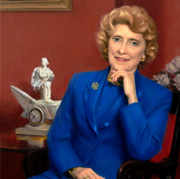The Lindy Claiborne Boggs Room
Cite this Page
Office of History and Preservation, Office of the Clerk, http://clerk.house.gov/art_history/art_artifacts/boggs-reading-room/artifacts.html, (December 03, 2010).
For Additional Information
Office of History and Preservation
(202) 226-1300
history@mail.house.gov
Art and Artifacts
Lindy Boggs Portrait
Lindy Claiborne Boggs, oil on canvas, Ned Bittenger, 2004Collection of the U.S. House of Representatives
A portrait of Lindy Boggs currently hangs in the foyer of the reading room. It includes a small replica of the Car of History clock, to show her deep love of history. The 1819 original is located just outside the Boggs room, in the old Hall of the House (now Statuary Hall). This interest led her to chair the Commission of the United States House of Representatives Bicentenary. Also, Boggs was the first woman to chair a major political convention, and championed women’s rights throughout her congressional career.
John Quincy Adams Bust
John Quincy Adams, marble, James Crookshanks King, 1845Collection of the U.S. House of Representatives
A year after Adams’s death, the House acquired a commemorative bust by John Crookshanks King, who had sculpted a clay version three years before Adams’s death. A plaque beneath the bust bears the following inscription, said to have been written by Charles Sumner:
“John Quincy Adams who, after fifty years of public service, the last sixteen in yonder Hall, was summoned thence to die in this room, 23 February 1848.”
Adams & Latrobe Couches
Adams couch, Benjamin Belt furniture manufacturer, first quarter 19th centuryCollection of the U.S. House of Representatives
The sturdy Empire-style sofa on which John Quincy Adams died is still in the suite. Made by local furniture manufacturer Benjamin Belt before 1829, it is nearly identical to a sofa by the same maker that was in the Supreme Court Chamber for many years. The so-called John Quincy Adams couch remained here for decades. Sometime after 1857, it was removed to the Supreme Court, but it was reclaimed by the House in 1931.
Curiously, while the sofa was located in the Supreme Court’s space in the Capitol, a second government official died on it, on January 26, 1899. Attorney General August Garland suffered from “apoplexy” while arguing before the court and was brought into the clerk’s office, where he was placed on the Adams sofa. He expired shortly thereafter.
The second couch in the room is significant in a less dramatic way. It belonged to Benjamin Latrobe, the room’s architect. The curve-back couch from the early 1800s was a gift to the Capitol from the architect’s descendants.
Botanical Mirror
The Rococo Revival mirror over the mantel of the main room came to the room in 1962. Dating from the 1860s, and decorated with golden pineapples and ears of corn, this piece was formerly in room H-142, the first women’s lounge.
When the Congresswomen were assigned their new, larger quarters, they signed a discharge petition to have the mirror moved with them, stating that it was “especially meaningful” to them, and that “no other mirror would be appropriate in our new rooms.”






